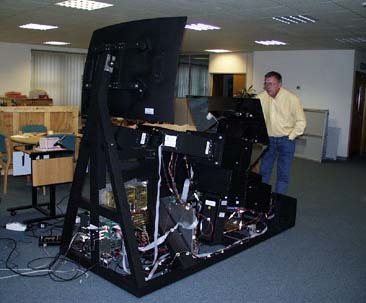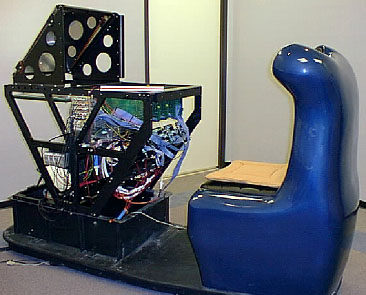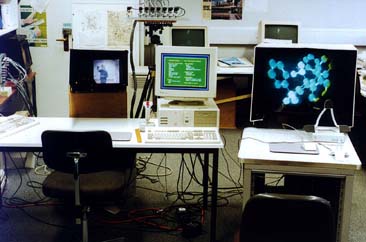Stereoscopic 3D Displays
Enhancing depth cues in 3D displays using real-time user feedback
Świrski's work is into enhancing the depth cues in personal stereoscopic 3D displays using real-time user feedback. Ideally, this would use very precise vergence information to drive feedback from the disaply. Currently, Świrski is building a binocular eye tracker on top of a pair of active stereo glasses, to track gaze position in 3D and adapt the focal blur of the displayed image to match the viewer's expectation.
Non-photorealistic rendering of stereoscopic video
Richardt's PhD (2007-2012) investigated the role of coherent depth in NPR, as both an input modality and in terms of assessing stereoscopic viewing comfort. A central component of his work was RGBZ videos. His dissertation considers the full life cycle of these videos: from their acquisition, via filtering and processing, to stereoscopic display.
The Cambridge Autostereoscopic Display
Neil Dodgson, Adrian Travis (Microsoft Research, formerly Department of Engineering), John Moore & Stewart Lang
The Cambridge autostereo display project (1989–1998) was a collaboration between the Department of Engineering, the Computer Laboratory and a number of commercial organisations. It produced several displays based on technology which produces true stereoscopic imagery without the need for any special glasses or other headgear. The Rainbow Group at the Computer Laboratory produced the computer interfaces to the display, wrote demonstration software, designed a camera system to provide live 3D video input, and analysed the mechanism by which the display works. The Laboratory has published around twenty papers on various aspects of the display.
The first displays were built in the late 1980s and early 1990s. Since 1995, the display was pushed towards commercialisation by a consortium of companies in the UK, USA and Korea. In its day, the 50″ display produced a more compelling autostereoscopic effect than any competing technology. While ahead of its time in image quality, commercialisation was unsuccessful. The technology suffered from the length of its optical path length: in the 50″ version the distance from the CRT faceplate to the viewer was over four metres; even with several mirrors to fold the optical path, the displays were bulky. Flat panel autostereoscopic displays have since been more successful commercially, though no flat panel display has yet matched the quality of the 1999 Cambridge 50″ display.
Both Prof. Dodgson and Dr Travis have continued with work in the area. Prof. Dodgson is on the committee and sometime chair of the annual Stereoscopic Displays & Applications conference, the principal venue for the dissemination of results in the field.

50″ autostereo display
The final (1999)
version of the display built by the original Cambridge team. This
has a 50″ diagonal screen and two viewing lobes, each with
15 views. It is described in our paper “A 50″
time-multiplexed autostereoscopic display”
(N. A. Dodgson, J. R. Moore, S. R. Lang, G. Martin and P. Canepa;
Proc. SPIE 3957, SPIE Symposium on Stereoscopic Displays and
Applications XI, 23-28 Jan 2000, San Jose, California).

25″ autostereo display
The 25″
diagonal, 28 view autostereoscopic system, first demonstrated in
1997. This was the first of the third generation displays, which
utilises our 285 kHz line rate CRT drivers. The front lens of the
display is horizontal, viewed through the diagonal mirror. The
four CRTs are mounted just in front of where the viewer's knees
would be. The blue plastic seat was designed for video game
applications. There were speakers at the top of the seat and
matching packaging to surround the display.

Older displays (click
to enlarge image)
Two of the second generation
model of the Cambridge autostereo display, developed in the early
1990s. On the left is a colour 10″ screen diagonal model,
showing a live video image which is being captured by the array of
cameras at the top of the picture. John Moore can be seen on the
display’s screen, taking the photograph. On the right is the
prototype 25″ model, displaying a greyscale image of an
organic molecule. In front of this is a Logitech 3D mouse.
Between the two displays is a PC,
containing an off-the-shelf graphics card (from Datapath),
used to generate images for the displays. The photograph was taken
in August 1995.
The display on left and the camera system were still operational in February 2010, a tribute to the engineering genius of John Moore.
